|
The resulting PDO is then polymerized in a condensation reaction with terephthalic acid to give PTT. The structure of PTT is shown in Figure 2.
 |
Polypropylene is the polymer of choice in spunbond applications. It is relatively low in cost, and easy to extrude. For many applications, it is ideal. However, it is hard to sterilize, and still lacks in softness. This paper discusses the use of PTT to make spunbond fabrics.
Experimental
Polymer: CORTERRA(tm) PTT polymer with an intrinsic viscosity of 0.9 dl/g (measured in a 50/50 mixture of methylene chloride and trifluoroacetic acid at 30°C) was processed as previously reported (5,6,7).
Spunbond: Spunbond was run at Hills, Inc. in Melbourne, Florida (5, 6). Unfortunately, no calender roll or bonding equipment was available with the Hills line. Spunbond was also run at Tandec on a Reifenhauser spunbond line. Exxon 3445 polypropylene resin was used as a control for making PP spunbond.
Results and discussions
PTT POY fiber, which is subsequently drawn into textured yarn, exhibits facile extrusion at a range of speeds from 600 meters per minute to 5000 meters per minute. These fibers can then be subsequently drawn in a draw-texturing unit at speeds from 450 to 1100 meters per minute.
Figures 3 and 4 below show PTT POY spinning speed vs. tenacity and percent elongation, respectively. PTT has a spin speed to POY yarn property relationship which is similar in its development trend to PET POY.
However, a PTT POY fiber spun at 3000 meters per minute has a lower percent elongation, and a lower tenacity than that of PET POY. The PTT POY fiber is more pliable, and results in a softer hand, both in the POY and in the finished woven fabric. PTT POY is mostly amorphous when spun at 2000 meters per minute. However, when spun at 5000 meters per minute, PTT shows marked crystallinity.8 Furthermore, while PET POY develops modulus as one increases crystallinity, the modulus for PTT POY remains virtually constant. This means that fibers spun in the Hills process would give a spunbond web composed primarily of higher crystallinity fibers (less amorphous), whereas the fibers from the Reifenhauser line (lower process speeds) are considerably more amorphous, and would produce a more amorphous spunbond web, due to lower process speeds. Figures 3 and 4 also show that there will be a drastic difference for a PTT POY spun on the Reifenhauser line vs. the Hills, Inc. line due solely to the fiber properties expected. One would expect a lower tenacity, higher percent elongation fiber from the Reifenhauser process.
Table 1 shows a comparison between the PP spunbond fabric made on the Reifenhauser line vs. the PTT spunbond. Both virgin PTT and PTT with 0.4% TiO2 were used. While different machine conditions were used to try to control fabric basis weight, we were unable to vary greatly the melt pump speed. Small changes in the melt pump speed placed one in an unstable spinning condition. The spinnerette used in this trial has 0.4 mm capillaries. Two previous trials used 0.6 mm hole capillaries. Further trials will use even smaller capillaries.
Table 2 shows much more clearly the differences in denier or fiber size that the different spinning conditions caused in the PTT fiber.
Table 1 also shows that PTT on the Reifenhauser line gives an extremely dimensionally stable fabric. Note the low percent elongation of the PTT spunbond fabric. Basis weight alone does not account for this kind of difference in elongation.
Figure 5 shows a comparison of the thermal mechanical analysis (TMA) of PP vs. PTT. Note that PP has an area of shrinkage prior to melting, while PTT shows a much more gradual increase in elongation as a function of temperature. The relatively close MD vs. CD tensile for PTT could be explained on the basis of higher basis weight, but Figure 6 shows that the fabric is in fact equally stable in both directions. Figure 6 compared the TMA of the machine direction, the cross direction, and an edge sample (mostly fibers aligned in the direction of testing).
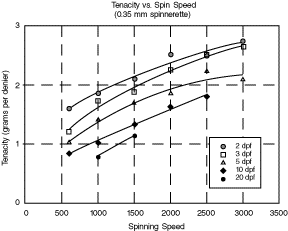 |
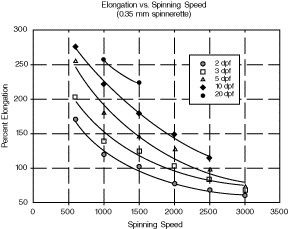 |
| Sample |
weight (g/m2) |
diameter |
|
Tensile (kg) |
elongation break |
Tensile (kg) |
elongation break |
| 1.1 PP |
|
|
|
|
|
|
|
| 1.2 PP |
|
|
|
|
|
|
|
| 1.3 PP |
|
|
|
|
|
|
|
| 2.1 PTT |
|
|
|
|
|
|
|
| 2.2 PTT |
|
|
|
|
|
|
|
| 3.1 PTT, .4% TiO2 |
|
|
|
|
|
|
|
| 3.2 PTT, .4% TiO2 |
|
|
|
|
|
|
|
A PTT spunbond shows drastically different properties than a PTT fully drawn yarn (FDY). Figure 7 compares the TMA of a PTT FDY vs. that of a PTT spunbond. Note that the PTT FDY shows a slight extension before 50 °C, but then retracts more than 10% between 50°C and PTT's melting point. By comparison, the spunbond shows a slow extension.
| Sample |
(g/m2) |
diameter (microns) |
filament |
| 1.1 PP |
|
|
|
| 1.2 PP |
|
|
|
| 1.3 PP |
|
|
|
| 2.1 PTT |
|
|
|
| 2.2 PTT |
|
|
|
| 3.1 PTT, .4% TiO2 |
|
|
|
| 3.2 PTT, .4% TiO2 |
|
|
|
In contrast to the fiber speeds of the Reifenhauser line (approximately 1500 to 2000 meters per minute), the Hills-Ason line showed much higher fiber speeds. Figure 8 shows a profile of linear fiber speed vs. throughput, while Figure 9 shows denier (dpf, or denier per filament) vs. throughput. All the data points greater than or equal to 0.6 gramsper hole per minute were run at fixed air pressure, due to a lack of additional air pressure. Note that some extremely low deniers (dpf) can be achieved.
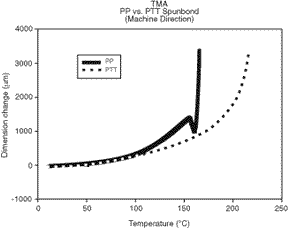 |
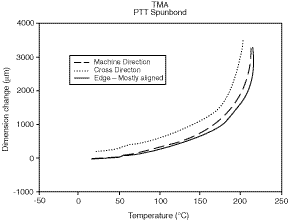 |
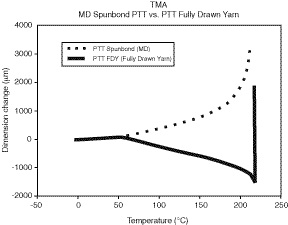 |
PTT spunbond fibers show the same softness that mechanically spun fibers show. Given the softness that PTT fibers possess, and the limitations on many current PP spunbond operations imposed by throughput at the spinnerette (g/hole/minute) and fiber speed, it is interesting to speculate on replacement of PP by PTT in a PP spunbond plant. The above, coupled with the higher density of PTT vs. PP (1.33 g/cm3 vs 0.91), and the ability to get to low dpf (less than 1) at moderate air pressures (78-80 psi), suggests outstanding spunbond fabrics with good formation and a plant throughput increase of from 50 to 100 percent, while maintaining good hand and drapability. Samples of PTT are being irradiated at 2.5 and 5.0 MRad to confirm the expected resistance to gamma radiation.
Resistance to gamma radiation remains a problem with PP spunbond.
Bicomponenent fibers of PTT/PET (side by side) were also spun on the Hills, Inc. line and showed the expected curling due to differential shrinkage. The spunbond fabric had excellent formation for both the homofil and bicomponent fibers.
Conclusion
PTT readily forms finer denier fibers at high speeds. The physical properties of the PTT spunbond web are quite different from other reported spunbond fabrics. Different spunbond processes will give very different PTT fabrics. The hand and bulk shown in PTT yarns is extremely good. PTT fabrics can be readily dyed by disperse dyes, and printing is facile.
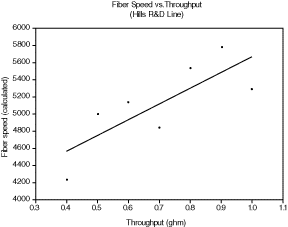 |
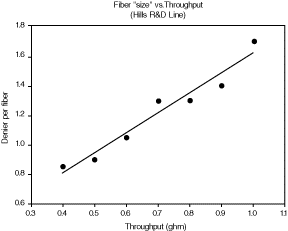 |
Acknowledgments
We wish to thank our many colleagues working on the current project. They include Case Baas, Mary Bowers, Phil Dalton, Ernest Evans, Imrich Greschler, John Ivey, Linda Oliveri, Jose Orantes, Adriano Pangelinan, Frank Smith, Russ Vinson, Pat Welch, and Frank Werny. We also thank Jerry Taylor and Arthur Tulley from Hills, Inc., and Dr. Larry Wadsworth, Dr. Sanjiv Malkan, Natalia Castillo and Jack Wyrick from Tandec.
Special thanks go to Janusz Grebowicz for his dynamic and thermal analyses.
References
- Contact: Arnold Wilkie, Hills, Inc., 7785 Ellis Road, West Melbourne, FL 32904.
- Contact: Dr. Larry C. Wadsworth, University of Tennessee - Tandec, 1321 White Avenue, Knoxville, TN 37996-1950.
- "Improvements Relating to the Manufacture of Highly Polymeric Substances," Br. Patent 578,079 (1941).
- "Polymeric Linear Terephthalic Esters," U.S. Patent 2,465,319 (1949).
- H.S. Brown, H.H. Chuah, "Poly(trimethylene terephthalate) - A New (Old) Fiber." Paper presented at The International Man-Made Fibres Congress, Dornbirn, Austria, September 25-27, 1996.
- H.S. Brown, H.H. Chuah, "Texturing of Textile Filament Yarns Based on Poly(trimethylene terephthalate)", Chemical Fibers International, 47:1, 1997. pp 72-74.
- H.H. Chuah, H.S. Brown, and P.A. Dalton, "Corterra(tm) Poly(Trimethylene Terephthalate) - A New Performance Carpet Fiber," International Fiber Journal, October, 1995.
- W. Oppermann, H.L. Traub, P. Hirt, H. Herlinger, "Fibres made of Poly(trimethylene terephthalate)." Paper presented at the International Man-Made Fibres Congress, Dornbirn, Austria, September 20-22, 1995.
This article is published on NF New Fibres, see the contents.